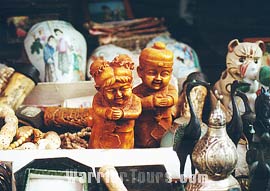Folk Toys

As a unique Chinese art form, folk toys are closely tied in with Chinese folk customs and people's daily lives, full of entertainment, appeal and rural life flavor. From primitive days, folk toys have developed along with Chinese society for thousands of years. Originally, they were especially for children to play with. Later, they gradually developed as a kind of folk art, mainly acting as decoration or knickknacks.
![]() History
History
The pottery and stone balls discovered in Banpo Museum of Xian tell us that folk toys had existed in people's lives since the earliest times. Along with the development and progress of society, the use of folk toys gradually extended. They weren't only playthings for children, but were also used to express people's psychological need for entertainment and creativity. For example, the pottery animals excavated from Hemudu Ruins in Yuyao City of Zhejiang Province and Shijiahe Relics in Tianmen City of Hubei Province are vivid and in various shapes, radiating primitive man's enthusiasm for creation and the pleasure of self-entertainment. In the Han Dynasty (206 BC - 220 AD), all kinds of pottery animals, houses, and servants were also used as funeral objects.
During the Tang and Song Dynasties (618 – 1279), Chinese folk toys came into their own. Toys of various quality appeared, such as sculptures of flour, porcelain and wood, toys made of silk and paper as well as colored drawings. Moreover, toys of that time became the symbols of the traditional festivals.
To the Yuan and Ming Dynasties (1271 - 1644), folk toys became delicate and involved in auspicious events. Folk toys reached their peak in the Qing Dynasty (1644 - 1911). In addition to the newly created varieties such as the 'Western Mirror' of Nanjing and 'Monkey Show' of Beijing, the materials, shapes and themes of the folk toys became more abundant. There were sculptures of spirits and Buddha as well as the molding of fairy story figures such as Kuan Kung (one of the Chinese gods of wealth), Yue Fei (one of the best-known generals in Chinese history), and Wu Song Fights the Tiger. Toys made of bamboo, cloth and many other materials were also developed.
![]() Classification
Classification
![]() Sculptures:
Sculptures:
they include pottery, clay, stone, flour, porcelain toys and so on. They were mainly for people's entertainment, with the animals as the theme. Later, they are also used as presents or as decorations in houses.
![]() Wooden and bamboo toys:
Wooden and bamboo toys:
kites, yo-yos, and windmills are representatives of these types of toys. There are bamboo mugs, boxes, whistles, birds, dragons and other bamboo objects made in Guangdong, Fujian and Zhejiang Provinces as well as some wooden carriages and wheels. These are for people's daily use or entertainment.
![]() Knitted toys:
Knitted toys:
with grass, reeds, cornstalk, corn husk and leaves of the palm trees as the materials, dragons, snakes, fish, grasshopper mantis, and other animals or shapes are made through knitting, knotting, interweaving and other skills. Nowadays, they have become a kind of handcraft in China.

![]() Embroidery and sewn toys:
Embroidery and sewn toys:
most of these are cloth toys. People use rags to stitch the shapes of tigers and cats which are filled with cotton wool or scrap cloth, and on the outside they are embroidered with colored patterns. They are often used as pillows for children, and some of the embroidery and sewn toys made in Chaozhou City, Guangdong Province have been exported.
![]() Educational toys:
Educational toys:
these are made to cultivate and develop children's intelligence as well as to improve their imagination in arts such as puzzle ring and tangram.
![]() Specialties:
Specialties:
Chinese folk toys are made of the most easily available local materials at low cost. They are simple in technique and shape; they are brilliant in color. They are made with rustic simplicity and vivacity, drawn from people's daily lives, customs, wishes and ideals. They are favored at home and abroad for their unique local styles and natural simplicity.
![]() Festival and Ceremony Toys:
Festival and Ceremony Toys:
Being auspicious and against evil spirits, Chinese folk toys influence people's lives deeply. There are special toys for most traditional festivals like fireworks and firecrackers for the Spring Festival, lanterns for the Lantern Festival, kites for the Festival of Pure Brightness and fragrant sachets for the Dragon Boat Festival.
Besides, there are folk toys for weddings, birthdays and religious celebrations. For example, the paper-cut-outs for weddings, men, horses, sedans and other paper-made objects for funerals, cloth tigers for children on their first and second birthdays, and all kinds of clay and pottery statues of Buddha at religious ceremonies.

